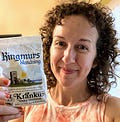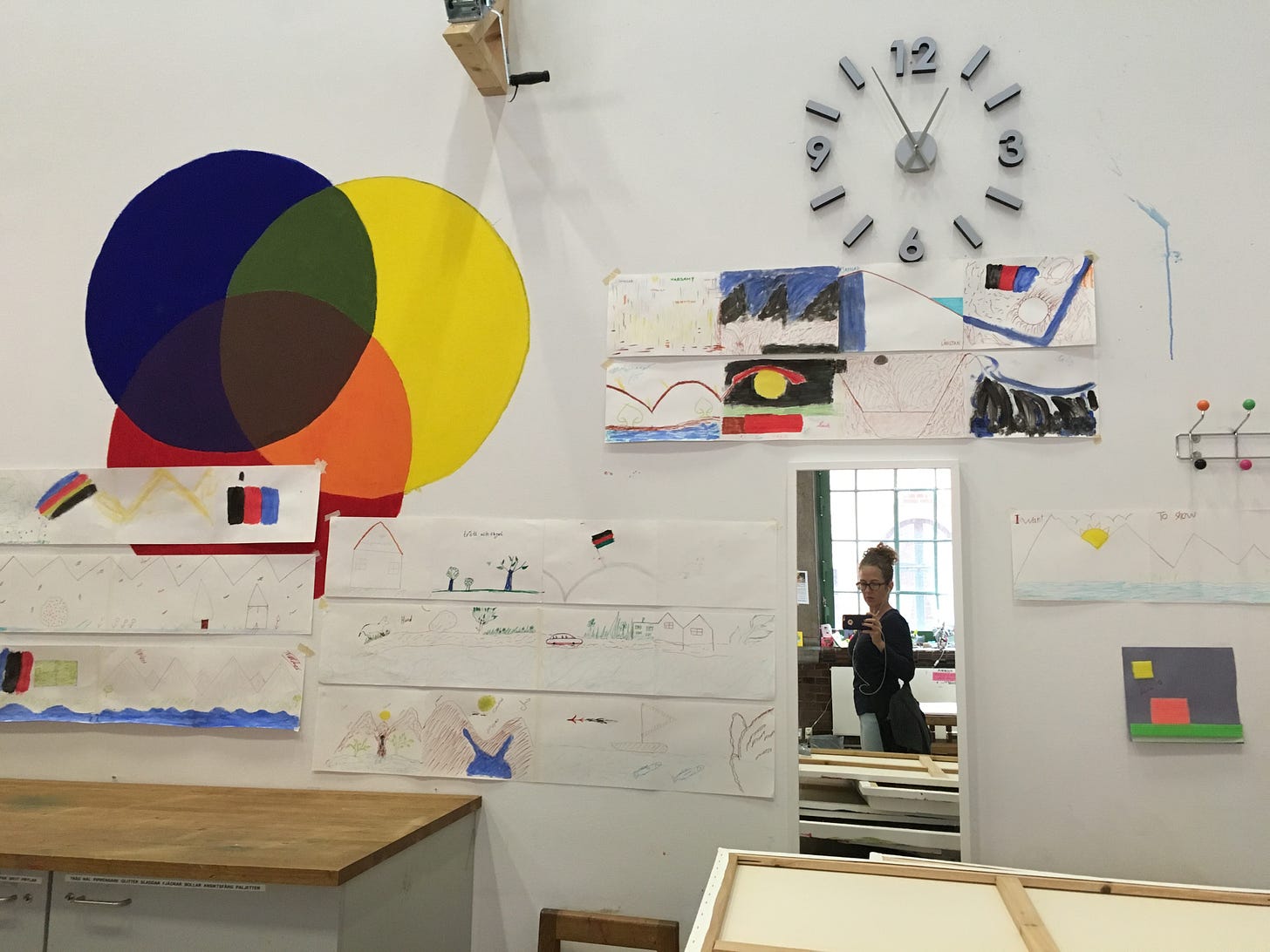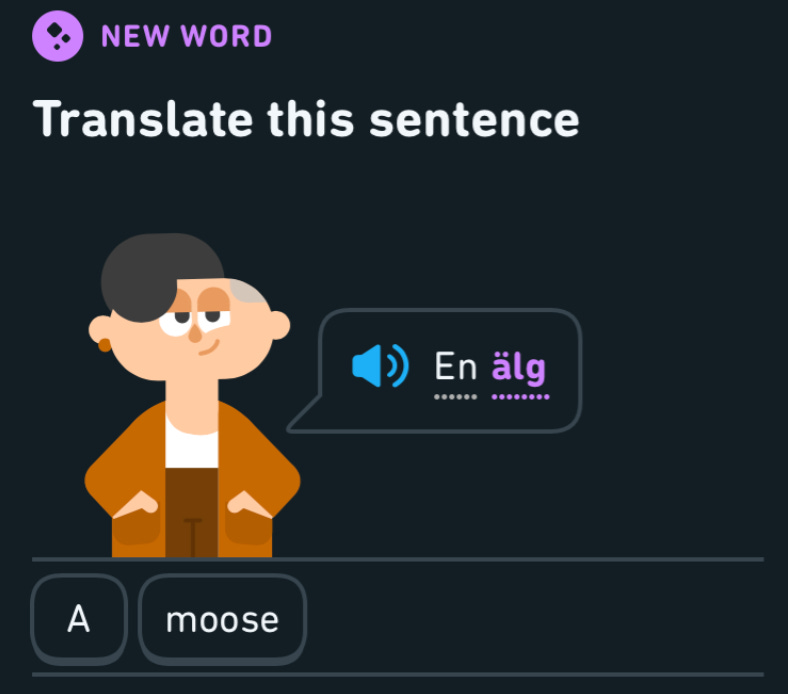Jag är en kvinna
My latest ancestral adventure is rewiring my brain, one Duolingo lesson at a time.

Swedish isn’t my mother tongue.
It’s my great-great grandmother’s tongue.
By the time my grandmother was the family elder, she remembered one or two words her mother had taught her. (Toilet, or toalett, was one of them.) Her mother was a first generation Swedish American who likely forgot most of the Swedish she learned from her immigrant parents, Karolina and Gustav, who immigrated in the late 1800s.
These are the Swedish ancestors whose immigration story caught my attention in the years before my grandmother died and inspired a trip with my sister in 2015 back to Gotland, where they left.
I came back from that trip speaking exactly one phrase: “Tack sa mycket” or “thank you very much.”
But all these years later, my interest in Sweden has skyrocketed. I still don’t care for ABBA (sorry, not sorry), but if I get the chance to go to IKEA or catch an episode of “Welcome to Sweden,” a short-lived sitcom on NBC, I’m there.
Until my mid-30s, I’d never paid much attention to this part of myself or my family history.
Instead, I spent a decade immersing myself in Spanish, a language that offered me a lifeline when I was a teenager who was desperate to escape the monoculture of my small town Midwestern experience.
Spanish took me out of my American-centered comfort zone. Learning this second language opened up doors for travel, but more importantly, it allowed me to form friendships and have conversations with strangers many thousands of miles from my home.
Half a billion people speak Spanish, including millions in my current home state of Texas. I don’t regret learning it, but it has been a humbling realization that, no matter how much I polish those language skills and use those skills as a way to better understand a culture that is not my own, Spanish will never be mine. I will always be an outsider when I speak it.
As I have been learning how to tread lightly with Spanish — to listen more than I speak, to respect the language and those who speak it by being aware of the privilege I bring to the space — my curiosity about learning Swedish has increased.
Finally, this spring, I decided to see where Duolingo might take me.
This platform has perfected the art of gamifying language acquisition, and I was amazed at how quickly I was learning the very basic words: I, you, they, him, her, apple, cat, dog, milk, water. Within a couple of weeks, my vocabulary was expanding: elephant, turtle, bird, knife, spoon, plates, menu.
Verbs started to trickle in: drink, eat, have, are, read, talk, like and love.
I’m on a 46-day streak at the moment. I admire people who can keep up epic streaks of meditation or running or stitching embroidery, but it’s not about a streak. Or even a goal. I’d like to one day be able to return to Sweden with my mom and my sister and my kids so we can meet the Swedish relatives we met virtually after our trip.
It’s almost assured that anyone in Sweden I would want to talk to will speak more English than I speak Swedish, but this is an inside job. A project for my heart. A practice for my ancestral spirit. Each time I open the app, I’m opening the portal to another place, another time, another existence.
One lost letter. One homesick night. One unfortunate bought with cholera. Each and every one of our lineages can change in a moment. A decision we make today can ripple through the branches of a family tree for generations to come.
My ancestors’ Americanization happened slowly. They learned English without the benefit of technology that, today, can connect people to fellow learners across the globe.
My ancestors made their way in a new world thousands of miles from their siblings and parents and cousins and childhood friends. People whose names they remembered but whose faces they never saw again.
Karolina and Gustav learned enough English to get by during the rest of their days in the United States. The only thing that likely saved their sanity was immersing themselves in a Swedish community that helped them survive the cultural shift from Scandinavia to the Midwest.
Now the cultural shift is tilting the other way.
Over the past few years, I’ve been adding elements of Swedish culture back into my life. A coffee cup here. A textile there. A tattoo where I can’t miss it.
And now, the very language they used to share their innermost thoughts, their homesickness, their fears, their encouragement.
Incorporating these aspects of Swedish culture into my life has been such a beautiful way to work with my ancestors — to imagine their lives, their pain, their joys. It has allowed me to find a deeper understanding and empathy for why my family members are the way they are. It has allowed me to discover new parts of myself.
Jag är amerikansk. Jag är en mamma. Jag är en dotter. Jag är Addie.
Happy Friday, friends! I hope you’ve had a great week and are enjoying this Chamber of Commerce weather we’ve been having. (As if Austin needs it. Area home appraisals dropped this week, as well as the recent residential sales data, and the short of it is: Too much of a good thing is not a good thing.)
If you feel so inclined to vote for me in the Austin Chronicle Best of Austin Awards, I’d be honored! I’m up against heavy hitters at Eater Austin and the Statesman (loooove Nadia and Matthew) and one of my favorite food writers, Melanie Haupt, who recently took over editorial duties at the Chronicle.
One last note about learning Swedish for my fellow ancestry nerds:
I was particularly tickled when moose (älg) came up in my animals unit the other day. The Swedish side of my family has a thing with moose. A moose dance, a moose cake, a moose call. It’s an inside joke that goes back to my uncles’ high school years, when the youngest, Curt, towered above his older brother, Chris.
From a story I wrote in 2014 about that moose cake: “At one point, they shared ‘the moose car’ and invented a moose call that they’d sing out as a term of brotherly endearment, perhaps after a bout of roughhousing or charades gone wild.”
These are now the uncles who are also re-engaging with our Swedish heritage. Along with my mom, we’ve all been reading the Emigrant series from Vilhelm Moberg, who wrote a series of books about a family that immigrated from rural Sweden to rural Minnesota in the 1850s.
If you’re in the mood to make something tart and sweet with a little bit of texture from all those poppyseeds, here’s the recipe:
Lemon Poppyseed Bread (Moosebread)
This poppyseed loaf, which half of our family calls moosebread and the other half calls moose food, is easily one of the most treasured treats in my grandmother’s recipe box. Her recipe calls for butter extract and oil instead of butter, which gives you an idea of when the recipe was likely developed in some unknown Midwestern kitchen, and to honor that legacy, I’ve kept them in this modified version.
A note: The only real change in my version is swapping out orange juice in the glaze for Meyer lemon juice, one of my favorite ingredients this time of year, for my friend and fellow food blogger Kristina Wolter’s 12 Days of Meyer Lemon series on her blog, Girl Gone Grits (girlgonegrits.com). Wolter has had what might be the largest, most productive Meyer lemon tree in Austin, which last year gave more than 1,000 lemons. (Kristina’s tree died during the free of 2021. Yes, there were tears.)
1 1/2 tsp. baking powder
3 cup flour
1 1/2 tsp. salt
1 1/2 Tbsp. poppy seeds
2 1/4 cup sugar
3 eggs
1 1/2 cup milk
1 cup vegetable oil
1 1/2 tsp. vanilla extract
1 1/2 tsp. almond extract
1 1/2 tsp. butter flavor extract
2 tsp. Meyer lemon zest
For the glaze
1/2 cup Meyer lemon juice
1/2 cup sugar
1/2 tsp. butter flavor extract
1/2 vanilla extract
Preheat oven to 350 degrees. Spray two 9-inch-by-5-inch loaf pans with cooking spray and set aside.
In a large mixing bowl, combine baking powder, flour, salt and poppy seeds. In another bowl, whisk together sugar, eggs, milk, oil, extracts and zest. Slowly pour the wet ingredients into the dry ingredients and thoroughly combine. Divide the batter between the two loaf pans. Bake for about one hour until middle of the bread has set.
During the last 10 minutes of baking, make the glaze by heating the glaze ingredients in a small saucepan over medium heat. Simmer for a few minutes and then turn off heat.
Right after you remove the loaves from the oven, slowly pour glaze on top of each loaf. Once the loaves have cooled, remove from pan and wrap in plastic wrap. Serve slices of bread at room temperature or warmed slightly. Makes two loaves.
— Addie Broyles






Jag ar en mormor.